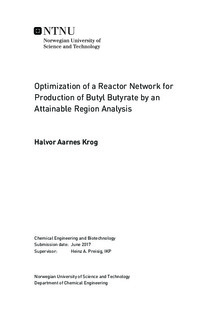Optimization of a Reactor Network for Production of Butyl Butyrate by an Attainable Region Analysis
Master thesis
Permanent lenke
http://hdl.handle.net/11250/2457797Utgivelsesdato
2017Metadata
Vis full innførselSamlinger
Sammendrag
Butyl butyrate is a promising supplement for jet fuel and diesel. It can be produced in a biotechnological process, by an esterification reaction between butanol and butyric acid. These intermediates can in turn be produced by fermentation. This work focuses on optimizing the reactor network which are required to convert sugar to the intermediates butanol and butyric acid, and the subsequent esterification of these intermediates to form butyl butyrate. The optimization was done by performing an attainable region analysis on the system.
Two different process designs was evaluated. In the first design, there were two separate fermentation networks, and the outlet flows were mixed and fed to the esterification reactor. In the second design, butanol was produced separately by fermentation. The outlet flow consisted of both substrate and butanol. It was fed to a reactor where butyric acid was produced by fermentation, and simultaneously converted to butyl butyrate.
The results showed that the maximum concentration of butyl butyrate was obtained by the second process design, which yielded maximum 16,42 g/L of butyl butyrate. This was considerably higher than the first design, which resulted in a maximum of 11,28 g/L of butyl butyrate. A possible reason for this deviation, is that the product inhibition of the cells which are producing butyric acid are reduced in the second process design. This is due to that butyric acid is reacting with the butanol to form butyl butyrate, hence, the concentration of butyric acid is maintained at low values. In addition, the feed concentration of butanol to the reactor producing butanol was higher in the second process design. The reason is because the butanol concentration was in effect diluted when mixed with the outlet flow from the fermenter of butyric acid in the first design.
